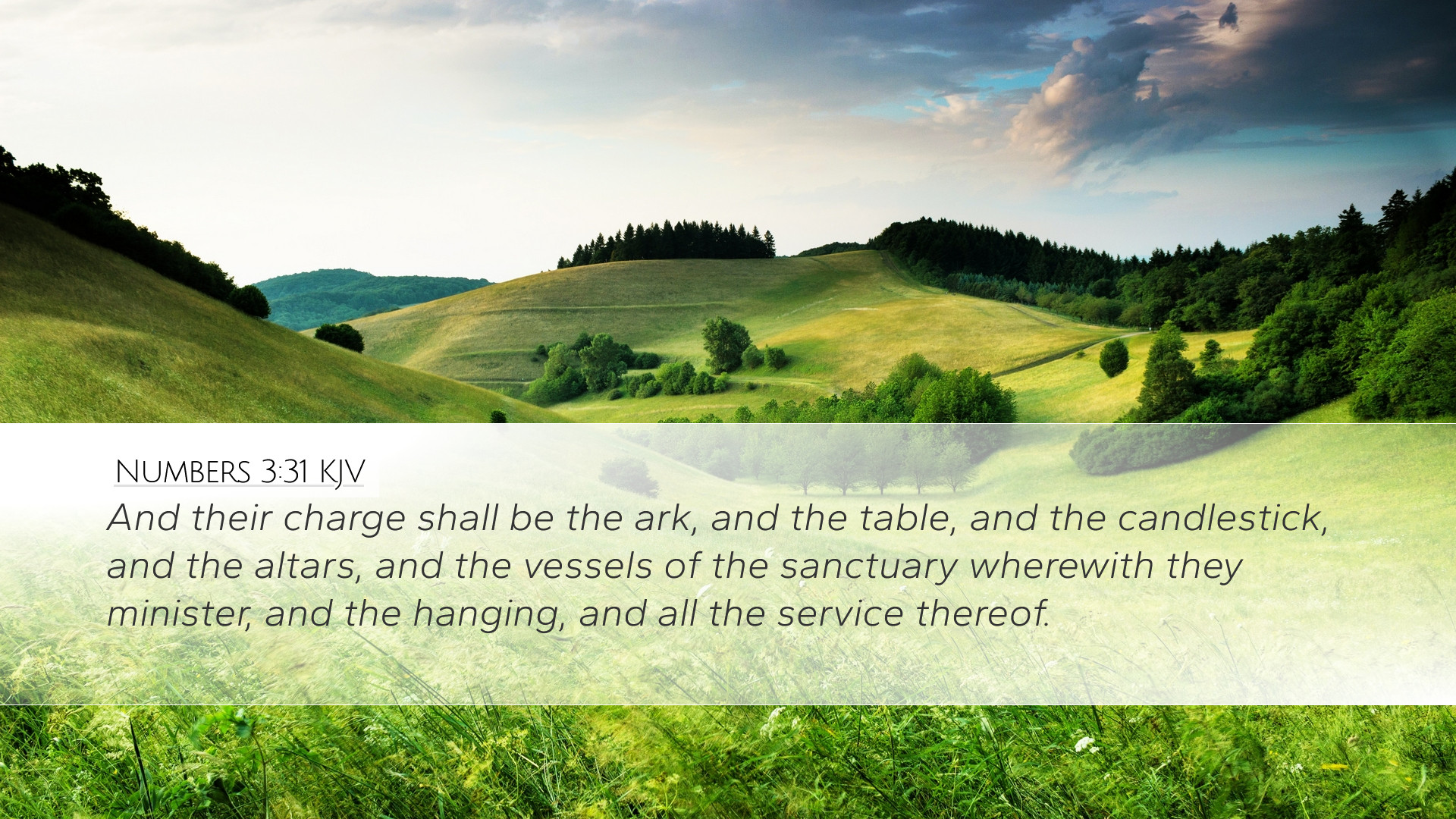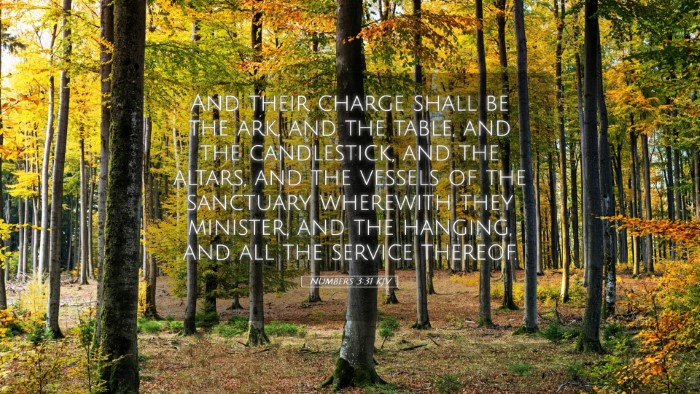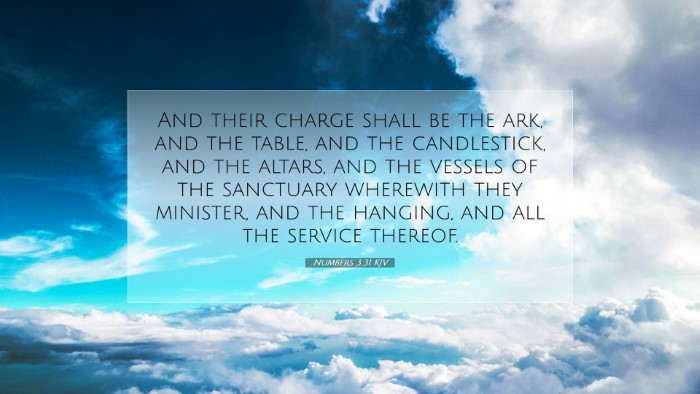Commentary on Numbers 3:31
Verse: "And their charge shall be the ark, and the table, and the candlestick, and the altars, and the vessels of the sanctuary wherewith they minister, and the hanging, and all the service thereof."
Introduction
The role of the Levites, particularly the family of Kohath, is underscored in Numbers 3:31. This portion of Scripture is pivotal in establishing the duties connected to the worship and service of God in the tabernacle, reflecting both historical and theological significance. In this commentary, we will explore various insights derived from public domain commentaries by Matthew Henry, Albert Barnes, and Adam Clarke, focusing on the implications of the Levitical responsibilities and their relevance for contemporary faith practice.
The Meaning of the Charge
This verse emphasizes the sacred responsibilities entrusted to the Kohathites, who were tasked specifically with the handling of significant ceremonial items, known in Hebrew as "kodesh." The verse lists key elements: the ark, the table (of showbread), the candlestick (menorah), and the altars. Each item symbolizes not just ritual but also represents the presence and holiness of God.
- The Ark: Considered the most important item, symbolizing God’s covenant presence. The Kohathites were called to protect and transport this holy object, indicating a direct connection to God's mercy and leadership through the atonement (Leviticus 16:2).
- The Table of Showbread: Represents God's provision for His people. The continual presence of this bread emphasizes God’s perpetual sustenance and fellowship with Israel.
- The Candlestick: The instructions regarding this item highlight the theme of light. The menorah symbolizes enlightenment and divine presence among His people, crucial to maintaining spiritual illumination.
- The Altars: The existence of altars reflects the importance of sacrifice and worship in the Israelite community, serving as a means for atonement and communion with God.
Historical Context
The Levites, chosen from the tribe of Levi, were separated for the service of the Lord; specifically, the sons of Kohath were assigned to carry the most sacred items of the sanctuary. Matthew Henry describes this as a divine appointment, emphasizing that their roles were not just duties but also privileges showcasing God's grace extended to them (Henry's Commentary). The detailed instructions reflect God's desire for order, holiness, and reverence in worship.
Theological Implications
Albert Barnes highlights the theological dimension of the passage by linking it to God’s dwelling among His people. The specific mention of the "sanctuary" reflect a broader narrative involving God's revelation to His people and the methodology by which they could engage with Him. Such acts of service designated by God carried profound significance—they were essential for sustaining the covenant relationship.
Worship and Ministry Today
This dedication of service experienced by the Kohathites calls for contemporary reflection on church leadership and responsibilities. The sacredness of duties in ministry today parallels the reverence and commitment illustrated in the Old Testament. Adam Clarke emphasizes the need for modern believers to recognize that all forms of worship should align with God’s holiness, involving both active service and personal sanctification.
- Reverence in Ministry: Just as the Kohathites approached their responsibilities with great seriousness, today’s leaders must also treat their calling sacredly. The service they provide—from preaching to administration—must be conducted with prayerful regard for God's holiness.
- Communal Responsibility: All believers share in the role of serving God's purposes in their local communities. This reflects the communal aspect of worship informed by the duties of the Levites, which goes beyond individual spirituality to encompass corporate service.
The Role of Symbolism
The articles mentioned in Numbers 3:31 are rich in symbolic meaning. They act as reminders of various aspects of the believer's relationship with God. Matthew Henry notes that recognizing these symbols helps in understanding our approach to worship today.
Symbolic Interpretations:
- Ark of the Covenant: Represents God's omnipresence and supreme authority in governance, which transitions into Christ’s lordship in the New Covenant.
- Table of Showbread: A precursor to the Last Supper, it foreshadows Jesus as the Bread of Life, linking provision with sacramental understanding.
- Candlestick: Symbolizes Christ as the Light of the World, affirming that in Him, holiness and revelation merge.
- Altar of Sacrifice: Connects to the redemptive work of Christ, fulfilling atonement and allowing believers direct access to God.
Conclusion
In Numbers 3:31, we encounter a profound encapsulation of the responsibilities and symbolic meanings behind the sacred items within the Israelite community. Through examining the Kohathites' charge, we glean essential insights beneficial not only to pastors and theologians but also to all believers. As we reflect on these duties and their implications for our own lives, may we be led to a deeper reverence for God’s holiness and a more committed service in our calling.


